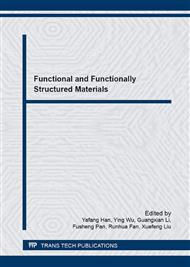p.152
p.160
p.167
p.174
p.179
p.184
p.189
p.196
p.205
Nonisothermal and Isothermal Degradation Kinetics of Thermotropic Liquid Crystal Copolyesters Containing BPA and BPAF Units
Abstract:
The thermotropic liquid crystal copolyester P-BPA2.5 and P-BPAF2.5 with low melting temperature and high glass transition temperature were obtained by introducing 2.5mol% bisphenol A (BPA), bisphenol AF (BPAF) and terephthalic acid (TA) receptively into the molecular chain of poly (oxybenzoate-co-oxynaphthoate). The isothermal and nonisothermal degradation behavior of the two copolyesters P-BPA2.5 and P-BPAF2.5 were studied by thermo-gravimetry analysis (TGA) under nitrogen atmosphere. The degradation kinetics of the copolyesters under dynamic and isothermal heating conditions was evaluated byKissinger-Akahira-Sunose (KAS) and iso-conversional methodrespectively. Results showed that the activation energy (E) values followed the order P-BPAF2.5>P-BPA2.5 under dynamic heating atmosphere. However, the P-BPA2.5 showed a better thermal stability as compared with P-BPAF2.5 under isothermal heating conditions. The differences of degradation mechanism between the two copolyesters may be a reason for this phenomenon, which was discussed in detail in the text.
Info:
Periodical:
Pages:
179-183
Citation:
Online since:
March 2016
Authors:
Price:
Сopyright:
© 2016 Trans Tech Publications Ltd. All Rights Reserved
Share:
Citation:


